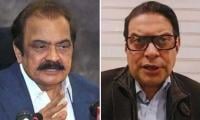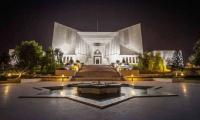To shed light upon the role of the superior judiciary, the necessary prerequisite is to understand the idea of a state as an entity and the administration of a state under its constitutional framework.
Article 7 of the constitution defines the state as “the federal government, Majlis-e-Shoora (Parliament), a provincial government, a provincial assembly, and such local or other authorities in Pakistan as are by law empowered to impose any tax or cess”.
A state can also be defined as its territory and the people living within that territory. The affairs of the state are run by the people through their representatives who prepare a constitution which is called the mother law. The constitution lays down the structure of the state by creating various institutions and offices to run the affairs of the state as per the mandate given under the constitution.
No person or institute is above the constitution and the state. This is aptly demonstrated by the execution of King Charles I of England in 1649 AD on the charge of ‘treason against people’. The charge underscores the notion that the king is also just a position within the state. Therefore, above all institutes and persons running those institutes are the people with the power to prepare the constitution and establish the institutes and hierarchies as only people have the power to change the constitution anytime and redefine the roles of various institutes and offices created under the constitution.
The present constitution of Pakistan, adopted in 1973, is the first constitution composed of the directly elected representatives of the people. Unanimously adopted by the ruling party and the opposition, it is as such the ‘will of the people’ to run the affairs of Pakistan.
The 1973 constitution defines ‘fundamental rights and Principles of Policy’, ‘the federation of Pakistan’, comprising the president, the Majlis-e-Shoora (parliament), the composition, duration and meetings of parliament, provinces comprising the governors, provincial assemblies, the provincial governments, legislative and administrative competence of the federal and provincial governments, ‘judicature’; comprising the courts, and other provisions relating to elections, tribal areas, armed forces etc.
The first provision of the constitution secures the ‘fundamental rights’ for the welfare of the people, which is the basic objective of a State.
The judicature comprises the superior judiciary and the subordinate judiciary. The superior judiciary comprises the Supreme Court, the high courts and the Federal Shariat Court while the subordinate judiciary comprises district and sessions courts, tribunals, special civil and criminal courts etc. The ‘subordinate judiciary’ is established by the executive under respective federal and provincial laws and is under the ‘administrative control’ of the executive with its ‘functional superintendence’ under the respective high courts in terms of Article 203.
It is the responsibility of the government or the executive through bureaucracy, law-enforcement agencies, and the subordinate judiciary to provide justice to the people. The superior judiciary is totally independent of the executive as it is directly established under the constitution. Hence it serves as a check upon the executive to ensure that the affairs of the state are being run as per the provisions of the constitution.
Under the doctrine of trichotomy of power, the legislature makes the laws, the executive implements these laws, and the judiciary interprets these laws. But these three institutes are not on equal footing.
Parliament has dual roles of being the constituent assembly and the legislative assembly or the legislature. In the role of the ‘constituent assembly’, parliament is superior to any other institute as no other institute has the power to prepare and amend the constitution. Parliament also has the power to appoint the head of the executive (the prime minister) or remove him/her with a vote of no-confidence, just like the board of directors of a company can remove a CEO.
Parliament as legislature is entitled to legislate laws strictly under the provisions of the constitution. Therefore, if a law is ultra-vires of the constitution, it is challenged under Article 199 before the high court which is part of the superior judiciary and has the power to interpret law in the light of the constitution to ensure citizens ‘fundamental rights’ as ‘fundamental rights’ are supreme to any law for the purpose of upholding the constitution or writ of the state.
In other words, the ‘legislature’ is the maker of the law, and the ‘superior judiciary’ is the checker of the law. Hence these two institutes are on equal footing.
The following summarizes the hierarchy of powers under the state: one, people elect and remove parliamentarians through their votes. Two, parliament as the constituent assembly prepares and amends the constitution. Three, the legislature makes laws under the constitution and the superior judiciary interprets the laws as per the provisions of the constitution. Four, the executive runs the affairs of the state as per the laws made by the legislature.
Ideally, every law, as soon as it is passed by the legislature, should be reviewed by the superior judiciary to assess and determine whether it is as per the provisions and dictates of the constitution. However, in the usual scenario, a law is not reviewed by the superior judiciary until a constitutional or writ petition (CP) is filed against it which results in unnecessary litigation at lower forums.
It is also to be noted that while a law is made by the legislature, there is no representation of the legislature before the high court in a CP. For instance, in a CP with respect to income tax, the respondents are the concerned tax officer, FBR and the federal government. All these respondents are part of the executive and hence have the same interests commonly leading to the abuse or misinterpretation of a law to their advantage.
Therefore, if a response of the legislature through some sub-committee of the parliament is obtained in every CP, it will facilitate in speedy disposal of CPs and will better inform the legislature whether the executive is administering the laws made by the legislature in their true spirit or if there is some flaw in the law that may be improved.
This in turn will eliminate unnecessary litigations resulting in efficiency and cost-saving of the society. The founder of Singapore said that a nation cannot progress whose previous generation leaves litigation as an inheritance for the coming generation. Only the timely establishment of rights and obligations helps a society progress.
Once a law is made by the legislature, the executive is given the power to make rules for the implementation of these laws – the executive cannot make a law but only the rule thereunder, which is called subordinate legislation. Hence, the executive is a level below the legislature. If a rule violates the parent law, it can be struck down by the high court in a CP.
To be continued
The writer is an advocate of the Supreme Court. He can be reached at: emad.hasan@euhlaw.com
On December 21, Trump unleashed fresh salvo, lambasting Panama for its "unfair" canal fees
According to Unicef, estimated 22.8 million children aged 5 to 16 are out of school in Pakistan
Famous Urdu slogan carrying incumbent PM’s name is ‘Shehbaz Karey Parwaz’, which means Shehbaz is high flier
Gender disparities are pronounced in KP, where girls account for 64% of OOSC
Chinese philosopher Mencius prophesized 3000 years ago that state that does not employ worthy perishes
Over past two decades, rapid and often chaotic development has increasingly defined Islamabad's landscape







